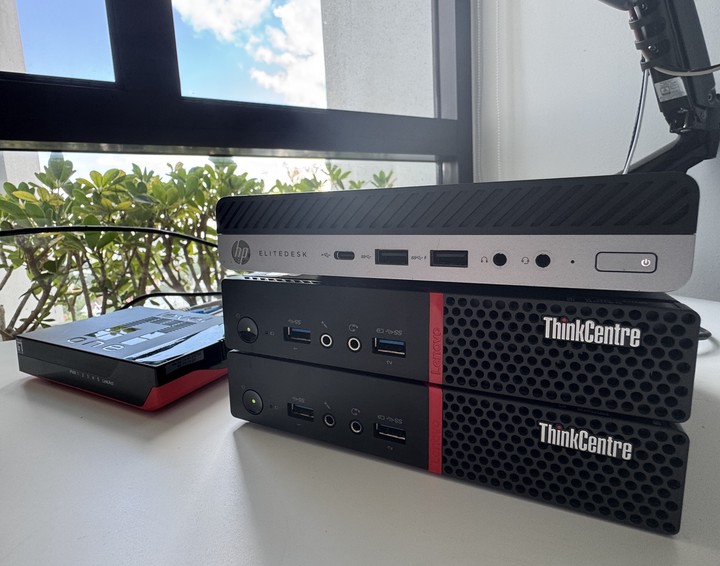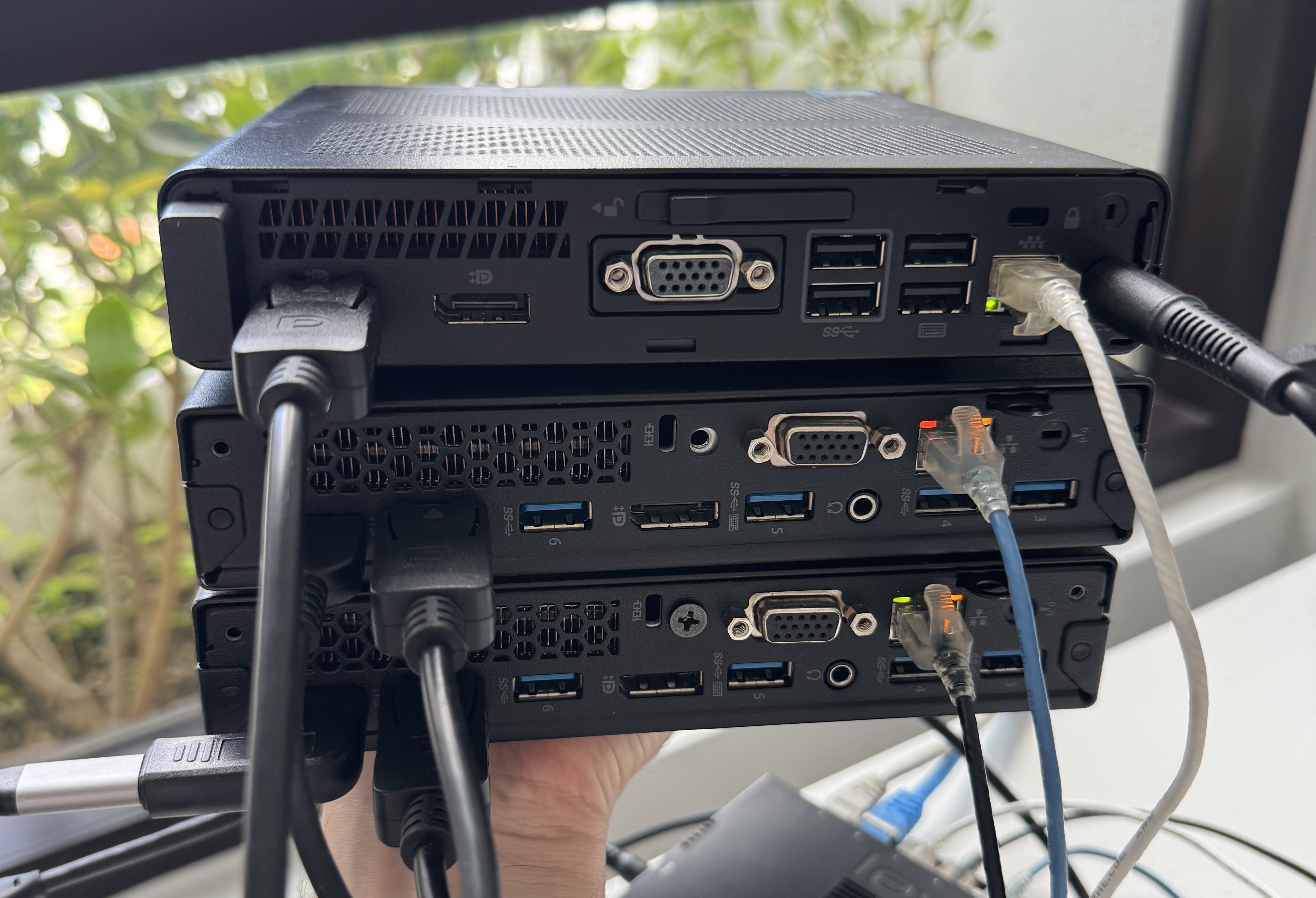Home Lab with Refurbished Thin Clients
 Refurbished thin clients powering a compact Kubernetes home lab
Refurbished thin clients powering a compact Kubernetes home lab
This document details the construction of a low-power, cost-effective Kubernetes home lab using refurbished thin clients. Aimed at technical audiences, it provides accurate hardware specifications, setup procedures, and performance insights for container orchestration learning and experimentation.
Key Advantages
- Feasibility: Transforming three refurbished thin clients into a functional Kubernetes cluster using Proxmox and Talos Linux is technically viable and demonstrably successful.
- Energy Efficiency: The system achieves a low idle power consumption of 28 Watts, minimizing operational costs.
- Cost-Effectiveness: The total hardware and upgrade cost is approximately $412 (based on 2023 pricing), offering significant value for a Kubernetes learning environment.
- Practicality: This setup serves as a practical home lab environment suitable for learning, testing, and deploying containerized applications. A successful NGINX deployment validates its functionality.
Hardware Overview and Justification
The home lab is built using a combination of Lenovo and HP thin clients, chosen for their compact form factor, energy efficiency, and upgradability.
-
Nodes:
- 2 x Lenovo ThinkCentre M700 Tiny: (Core i3-6100T, 32GB RAM, 512GB M.2 SATA each) - $33 each
- Justification: Cost-effective entry point with sufficient processing and memory for worker nodes. Supports Gen6 Intel Core and known for ~27-30W idle consumption.
- 1 x HP EliteDesk 800 G3 DM: (i5-6500T, 64GB RAM, 1TB PCIe 4.0) - $43
- Justification: Higher performance node for control plane or resource-intensive workloads. 1L form factor and energy-efficient design aligns with home lab requirements.
- 2 x Lenovo ThinkCentre M700 Tiny: (Core i3-6100T, 32GB RAM, 512GB M.2 SATA each) - $33 each
-
Upgrades:
- 4 x 16GB DDR4 SODIMM (~$80 total)
- 2 x 512GB M.2 SATA SSDs (~$50 total)
- 2 x Lenovo DC plug to USB-C PD triggers (~$6 total)
- 2 x 32GB DDR4 SODIMM (~$100 total)
- 1 x 1TB PCIe 4.0 SSD (~$67 total)
Detailed Cost Breakdown (Approximate 2023 Pricing):
| Component | Quantity | Unit Cost | Total Cost |
|---|---|---|---|
| Lenovo ThinkCentre M700 Tiny | 2 | $33 | $66 |
| HP EliteDesk 800 G3 DM | 1 | $43 | $43 |
| 16GB DDR4 SODIMM | 4 | ~$20 | $80 |
| 512GB M.2 SATA SSD | 2 | $25 | $50 |
| Lenovo DC plug to USB-C | 2 | ~$3 | $6 |
| 32GB DDR4 SODIMM | 2 | ~$50 | $100 |
| 1TB PCIe 4.0 SSD | 1 | $67 | $67 |
| Total | $412 |
Note: Prices are indicative from 2024 and may vary. Verify current pricing for accurate cost estimation.
 |
 |
 |
|---|---|---|
 |
 |
 |
Software Stack and Configuration
The setup leverages open-source software for virtualization and container orchestration:
-
Proxmox VE: Installed as the hypervisor on each thin client.
- Justification: Open-source, Debian-based, robust hypervisor simplifying VM management via a web interface. Supports a wide range of hardware and is suitable for home lab environments. (Proxmox VE)
- Installation Process:
- Download Proxmox VE ISO.
- Boot each thin client from ISO.
- Follow installation wizard, configuring network settings to ensure all nodes are on the same subnet for cluster communication.
- Verify hardware compatibility.
-
Talos Linux: Deployed as virtual machines within Proxmox to form the Kubernetes cluster.
- Justification: Immutable, secure, and purpose-built for Kubernetes. Declarative configuration simplifies management and optimization for cluster operations. (Talos Linux)
- VM Setup within Proxmox:
- Download Talos Linux ISO.
- Create VMs in Proxmox, allocating resources based on host capabilities. HP EliteDesk can host more resource-intensive VMs due to higher RAM capacity.
- Install Talos Linux within each VM.
-
Kubernetes Cluster Configuration (Talos CLI):
Visit the Talos Linux Getting Started Guide (https://www.talos.dev/v1.9/introduction/getting-started/) for a detailed walkthrough on setting up your Kubernetes cluster.
Performance and Efficiency
- Power Consumption: Measured at 28 Watts idle, confirming energy efficiency and low operational cost.
- Cost-Effectiveness: Total setup cost of ~$412 provides a highly affordable Kubernetes learning and testing platform.

Benefits of Talos Linux for Kubernetes Home Lab
- Enhanced Security: Immutable OS design reduces attack surface and improves system integrity.
- Simplified Management: Declarative configuration model streamlines cluster deployment and maintenance.
- Optimized for Kubernetes: Designed specifically for container orchestration, maximizing resource utilization on limited hardware.
Potential Use Cases
- Learning Kubernetes administration and container orchestration.
- Testing Kubernetes deployments and configurations.
- Running small-scale containerized applications for home services.
- Setting up CI/CD pipelines for development projects.
Expansion and Troubleshooting
- Expansion: Easily scalable by adding more thin client nodes. Explore other Kubernetes distributions or integrate monitoring and logging tools for advanced setups.
- Troubleshooting:
- Network Connectivity: Ensure all nodes are on the same subnet and can communicate for cluster formation.
- Resource Allocation: Monitor VM resource usage and adjust RAM/CPU allocation as needed, especially for Kubernetes components.
- Power Monitoring: Utilize tools like
powertop(Linux) to further optimize power consumption if required.
Conclusion
This project demonstrates the viability of building a powerful, energy-efficient, and cost-effective Kubernetes home lab using refurbished thin clients. The combination of Proxmox and Talos Linux provides a robust platform for learning and experimenting with container orchestration, making it an accessible and valuable resource for technical enthusiasts.